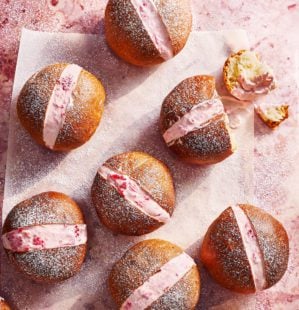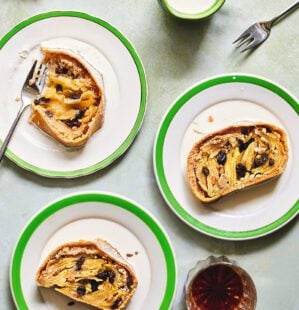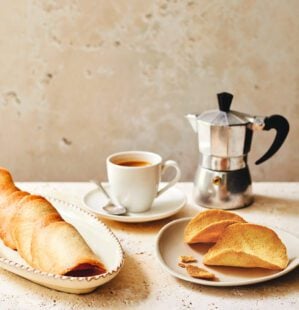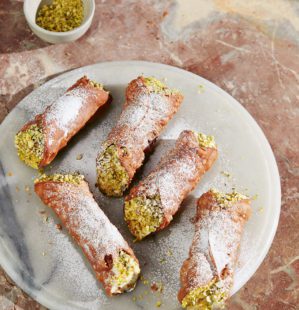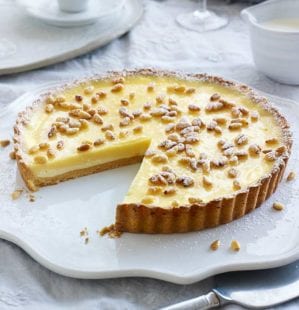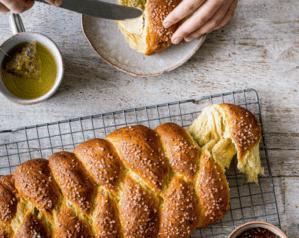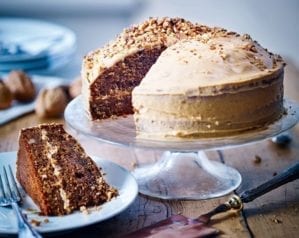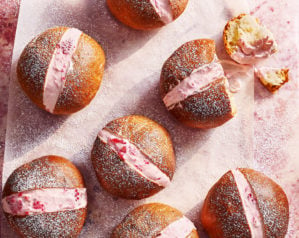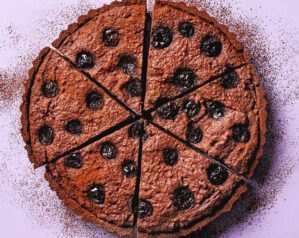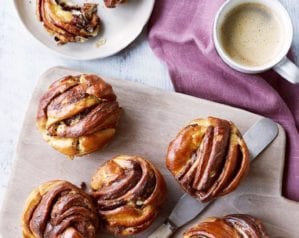
Maritozzi (Italian cream buns)
- Published: 4 Nov 24
- Updated: 4 Nov 24
In Rome they often start the day with a maritozzo – a light brioche bun, perfumed with orange zest and filled with fluffy vanilla cream. Learn how to perfect this classic with baker Roberto Nitti.
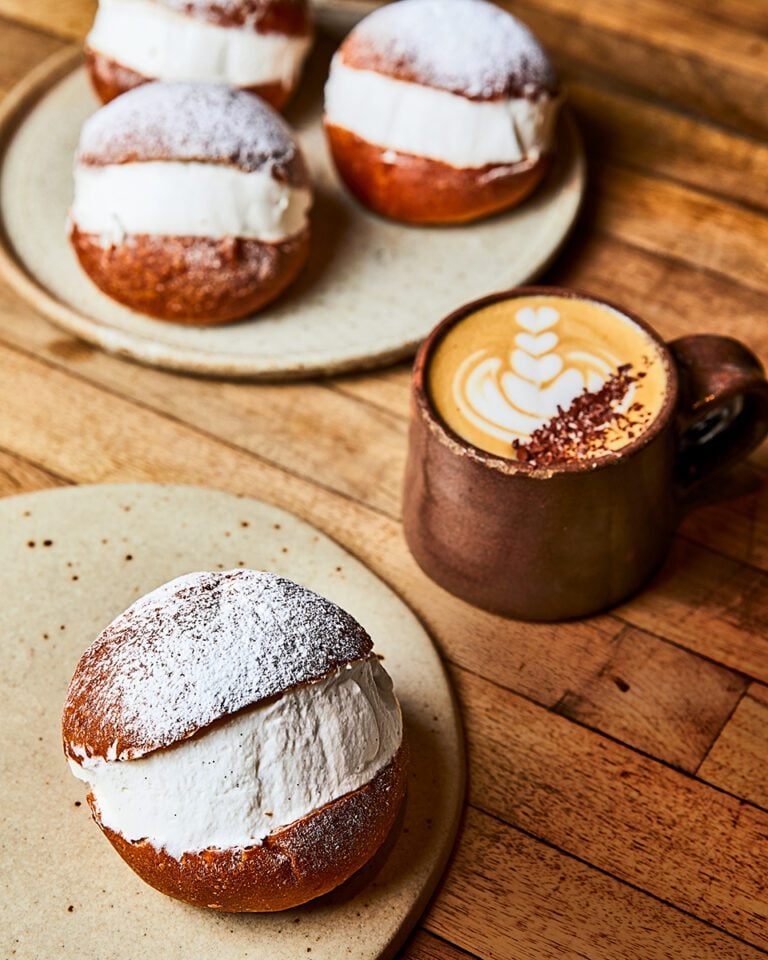
“Rome’s most iconic pastry, maritozzi are brioche buns filled with whipped cream. What sets them apart is how Roman pastry chefs elevate the dough,” says Roberto. “They mix flour, eggs and sugar, and add olive oil instead of butter, then infuse it with honey, vanilla and citrus zest. This makes maritozzi special and recognisable worldwide. While the process is lengthy, with several steps over two days and three leavening stages, the recipe itself isn’t actually that difficult.”
Going back hundreds of years, a maritozzo was originally a large loaf – fortified with eggs, olive oil and honey – eaten by labourers to keep them working through the day. In the Middle Ages, the loaves got sweeter and smaller and became a Lenten treat, as they weren’t made with butter.
During the 18th century, the buns were also linked to courting couples – the name is derived from marito, which is Italian for husband. A man would give a maritozzo to his prospective wife – perhaps with a ring tucked inside… Nowadays maritozzi are traditionally eaten for breakfast, but we think the aromatic citrus flavours and cream make them a perfect bake for any time.
Roberto embarked on his culinary journey at the CAST Alimenti cookery school in Brescia and completed a degree in pastry aged 18. Following his studies, he honed his skills in bakeries across Italy. At 25, he moved to Milan, where he worked at the Mandarin Oriental hotel before joining Panificio Davide Longoni. There, he mastered the art of the traditional Italian Christmas bread, panettone. Roberto then relocated to London and started working at Pophams, a small, well regarded group of bakeries, in 2023.
Mastered classic maritozzi? Try our raspberry versions next, or discover more sweet Italian baking recipes.
-
Makes 15
-
Hands-on time 1 hour, plus resting, proving and overnight chilling. Oven time 15 min, plus cooling
Before you start
Tips for making maritozzi
- Lievitino is an Italian pre-ferment that uses yeast, similar to a poolish (and wetter than a biga). Because the eggs, sugar and oil can all slow down the leavening of the dough, a lievitino gives the yeast some time to multiply and grow unhindered, helping to boost the rise of the dough.
- The windowpane test shows how well developed the gluten is in the dough – it needs to be stretchy, yet strong enough not to tear when pulled so thin that light can pass through. It’s a good test for enriched breads as the fat in the eggs limits gluten formation. That’s because it coats the gluten proteins, making it harder for them to bond together (hence why you knead enriched doughs more than usual to develop the required gluten). On the other hand, the eggs, oil and sugar mean the final baked result will be soft and tender.
- Stiff peaks: You’ve reached this stage when you take the beaters out of the cream and the peaks don’t flop over at the tip. If you do overwhip your cream slightly (it will look claggy and clumpy, like it’s splitting), add a splash more unwhipped cream and start whipping again gently and carefully – you’ll get more control at this stage if you whip it by hand.
Ingredients
For the lievitino
- 70g strong white bread flour
- 4g fresh yeast or 2.5g dried yeast
For the dough
- 90g (just under 2) eggs, beaten
- 125g whole milk
- 285g strong white bread flour, plus extra to dust
- 6g fresh yeast or 2.5g instant dried yeast
- 40g caster sugar
- 1 tsp runny honey
- 7g fine salt
- 55g olive oil
- Finely grated zest 1 orange
- 1 vanilla pod, split and seeds scraped, or 1 tsp vanilla extract
For the glaze
- 2 medium egg yolks
- 30g double cream
For the filling
- 750g double cream
- 75g caster sugar
- 1 tsp vanilla extract
- Icing sugar to dust
Specialist kit
- Piping bag with a wide nozzle
Method
- Begin with the lievitino (see Before You Start, tips for making maritozzi). In a bowl, mix the flour and yeast, then pour in 70g water and mix to a thick batter. Cover and leave at room temperature for 1 hour or until bubbly and doubled in size.
- For the dough, whisk the eggs and milk together and set aside. Add the flour, yeast and roughly three quarters of the egg and milk mixture to the bowl of a stand mixer with a dough hook attached. Start mixing at a low speed until a stiff dough forms.
- Add the sugar, honey and lievitino and continue to mix, gradually adding the remaining egg and milk mixture bit by bit. When everything is fully incorporated, turn the speed up slightly and keep mixing until the dough turns smooth and elastic. It’s ready when you can pull the dough between your hands to create a thin, almost translucent layer without it tearing. We call this the windowpane test (see Before You Start, tips for making maritozzi).
- With the motor still running, add the salt and drizzle in the olive oil bit by bit, making sure the oil is absorbed between each addition before adding any more. Add the orange zest and vanilla, mix until evenly distributed, then transfer the dough to a bowl. At this stage it should be soft and pliable but not sticky at all.
- Cover the bowl, leave it to rest for 45-60 minutes, then put it in the fridge to prove overnight.
- The next day, take the dough out of the fridge and leave it at room temperature for 30 minutes to slightly warm up. Divide it into 15 equal pieces, each weighing about 50g. Lightly dust the tops and work surface with flour. To form the dough into balls, use the palm of your hand to form a cupped shape around the dough with your fingertips lightly touching the work surface. Now move your hand in a vigorous circular motion. As your fingers and thumb move the dough, you’ll feel it catching the work surface so you’re almost pushing the edge of the dough under itself – as you do this and the dough rotates, the top will tighten slightly, gradually forming a smooth round ball.
- Put the balls, evenly spaced, on a baking tray (or several trays) lined with baking paper, leaving enough room around each one so they can double in size undisturbed. Cover the tray – a large plastic bag works well – then leave in a warm place for 60-90 minutes.
- Meanwhile, make the glaze for the maritozzi by whisking together the egg yolks and 30g double cream. Heat the oven to 175°C/gas 3 3⁄4 – it’s best to use a conventional rather than a fan oven setting here as this will help the buns rise evenly.
- Once the dough balls have doubled in size, gently brush each one generously with the glaze. Make sure they’re completely covered. Bake the maritozzi buns in the oven for 13-15 minutes or until the surface is golden. Remove, transfer to a wire rack and leave to cool completely.
- For the filling, whip the double cream, sugar and vanilla together using a stand mixer with the whisk attachment or an electric hand mixer until the mixture forms stiff peaks (don’t overwhip – see Before You Start, tips for making maritozzi). Transfer to a piping bag.
- Once the buns have cooled completely, cut them open (but don’t go all the way through). You can cut down the centre or, for a more traditional look, cut
at a slight angle from the centre. Open up the cut you make slightly, but again be careful not to open it so much that the bun completely splits in half. - Pipe the whipped cream inside each maritozzi, then smooth it flush against the edges of the bun with a palette knife. Dust the buns with icing sugar, then serve.
- Recipe from November 2024 Issue
Nutrition
- Calories
- 413kcals
- Fat
- 32g (17g saturated)
- Protein
- 5.1g
- Carbohydrates
- 26g (9.3g sugars)
- Fibre
- 0.9g
- Salt
- 0.5g
Buy ingredients online
Rate & review
Rate
Reviews
Subscribe to our magazine
Food stories, skills and tested recipes, straight to your door... Enjoy 5 issues for just £5 with our special introductory offer.
Subscribe
Unleash your inner chef
Looking for inspiration? Receive the latest recipes with our newsletter

